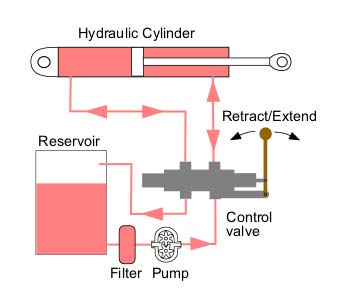hydraulics

A simple open center hydraulic circuit.
Hydraulics is the practical application of hydrostatics and hydrodynamics to engineering. Since any machine or structure that uses, controls, or conserves a liquid makes use of the principles of hydraulics, the scope of this subject is very wide. It includes methods of water supply for consumption, irrigation or navigation and the design of associated dams, canals, and pipes; hydroelectricity, the conversion of water power to electric energy using hydraulic turbines; the design and construction of ditches, culverts, and hydraulic jumps (a means of slowing down the flow of a stream by suddenly increasing its depth) for controlling and discharging flood water, and the treatment and disposal of industrial and human waste. Hydraulics applies the principles of hydrostatics and hydrodynamics and is hence a branch of fluid dynamics.
Any hydraulic process, such as flow of liquid through a turbine, may be described mathematically in terms of four basic equations derived from the conservation of energy, mass, momentum, and the relationship between the specific forces and internal mechanics of the problem. In hydraulic machines which transmit energy through liquids and convert it into mechanical power, three principles of liquid behavior that have been known for centuries are applied. Torricelli's law states that the speed of liquid flow from a hole in the side of a vessel increases with the depth of the hole below the surface of the liquid in it. Pascal's law states that the pressure in an enclosed body of liquid is transmitted equally in all directions. (The law is applied in a hydraulic press, in which a force applied over a small area by a piston is transmitted through the liquid filling the system to another piston with a larger area on which a much larger force will be exerted.) Bernoulli's law states that at any point in a tube through which liquid is flowing, if no work is done, the sum of energies due to pressure, motion (kinetic energy), and elevation (potential energy) of the liquid is constant. Thus by increasing the cross-section of the tube and slowing the flow down, kinetic energy is converted to pressure energy. The development of pumps in the 19th century, which converted mechanical to hydraulic energy and produced greater fluid velocities and pressures than had previously been obtainable, meant that hydraulic principles could usefully be applied to operate a wide variety of machines.
Self-contained hydraulic units consisting of an engine, a pump, control valves, a motor to convert hydraulic to mechanical energy, and a load were soon developed for use in industry and transportation. Hydraulics is now one of the main technologies for transmitting energy, comparing well with mechanical and electrical systems and having the advantages of being fast and accurate and good at multiplying forces. Hydraulic systems containing water, oil, or special fire-resistant fluids are used in airplane landing systems, automotive braking systems, and many other industrial applications.


